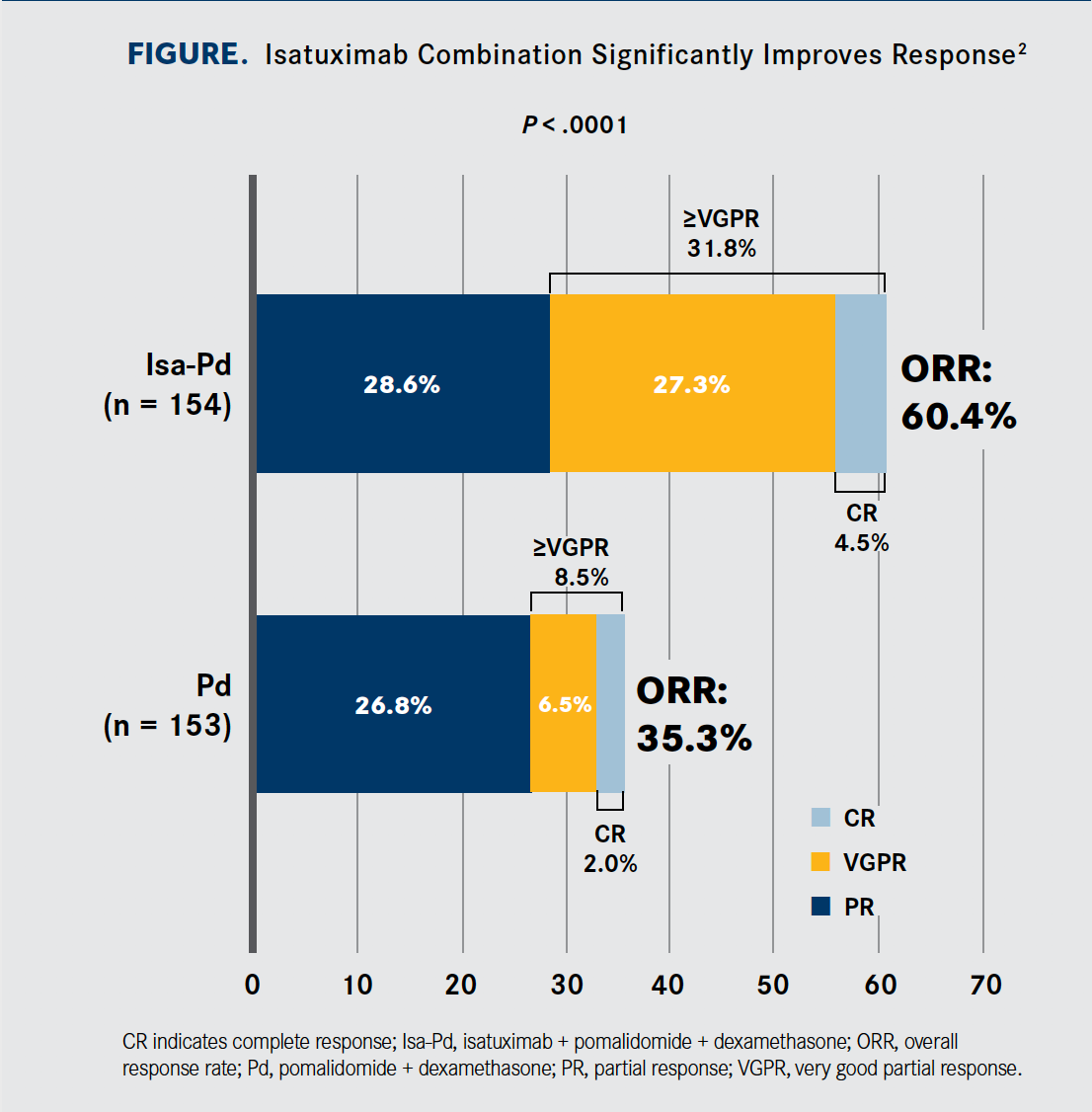Isatuximab Shows Promise in Relapsed/Refractory Multiple Myeloma
Joseph Mikhael, MD, discusses isatuximab in the context of recent, promising data from the ICARIA-MM trial in relapsed/ refractory multiple myeloma.
Joseph Mikhael, MD

Joseph Mikhael, MD
The novel agent isatuximab has demonstrated a significant progression-free survival benefit in the treatment of relapsed/ refractory (R/R) multiple myeloma, but further studies are needed to establish its place in the treatment paradigm, according to Joseph Mikhael, MD.
Isatuximab is directed at the CD38 receptor, which daratumumab (Darzalex) also targets. The differences between the 2 monoclonal antibodies must be clarified in ongoing investigation, Mikhael, a professor in the Applied Cancer Research and Drug Discovery Division at the Translational Genomics Research Institute in Phoenix, Arizona, said in an interview with OncLive. He also is chief medical officer of the International Myeloma Foundation.
Daratumumab is approved in several myeloma settings, including in R/R disease in combination with pomalidomide (Pomalyst) and dexamethasone.1
Mikhael discussed isatuximab in the context of recent, promising data from the ICARIA-MM trial (NCT02990338), in which the drug was tested in combination with pomalidomide and dexamethasone. Pomalidomide and low-dose dexamethasone are an approved and established regimen in the R/R myeloma setting. The novel triplet demonstrated a prolonged progression-free survival (PFS) benefit.2,3
Patients were randomized to receive either the isatuximab triplet (n = 154) or pomalidomide and dexamethasone (n = 153). All patients had received ≥2 lines of prior therapy, including lenalidomide (Revlimid) and a proteasome inhibitor.
Click to Enlarge

As for safety, patients treated with isatuximab experienced more grade ≥3 treatment-emergent adverse events (86.8% vs 70.5%), but mortality (7.9% vs 9.4%) and treatment discontinuation (7.2% vs 12.8%) were lower with the triplet than the control arm, respectively.
Further, the study results indicated that adding isatuximab to pomalidomide helped to reverse renal impairment: 31.3% of patients treated with the triplet experienced a sustained complete renal response versus 19.0% with the doublet.
In July 2019, the FDA accepted a biologics license application for isatuximab based on data from the ICARIA-MM study. A decision is scheduled to be made by April 30, 2020.
OncLive: How would you characterize the patient population in the ICARIA-MM trial?
Mikhael: The trial included patients with relapsed multiple myeloma who were previously treated with at least 2 prior lines of therapy. The isatuximab triplet would form their second relapse therapy. They could not have been previously treated with pomalidomide because that was one of the drugs being studied here in the ICARIA trial. In those 2 lines of prior therapy, patients must have had lenalidomide and a proteasome inhibitor.
Otherwise, there were some fairly typical exclusion criteria that we would use in a phase III study of myeloma. The key point is that these are patients who meet the criteria of [the FDA label indication] for pomalidomide. The setting for this experimental therapy is a situation where you would typically be using pomalidomide and we added isatuximab to that.
What was the rationale for the ICARIA-MM trial and the primary end points?
We are seeing a very clear trend in multiple myeloma that triplets work better than the doublet combination of pomalidomide. and dexamethasone. In this case we are comparing isatuximab, pomalidomide and dexamethasone with pomalidomide and dexamethasone. I had the privilege of leading the earlier phase Ib study that demonstrated that isatuximab and pomalidomide are a safe and feasible combination. We know by their mechanisms of action that there can be synergy between a monoclonal antibody and immunomodulatory agents. We have seen this previously with lenalidomide and now with pomalidomide.
As expected with a phase III study, the primary end point should be progressionfree survival. We anticipated that the primary end point of this study would demonstrate that the triplet combination would be superior to the doublet and then of course, these data would prove to be a pathway to registration for the drug.
Please explain the mechanism of action.
This is a very well understood mechanism of action. Isatuximab is a monoclonal antibody that is directed against the CD38 antigen, which is expressed on nearly all myeloma cells. In the myeloma community we are very familiar with it because it has a very similar, albeit slightly different, mechanism of action to daratumumab, which is already approved in this space.
Isatuximab interacts in the tumor environment to create an immunomodulatory effect, which is one of the reasons why we theorized that the agent would work particularly well with lenalidomide and pomalidomide. Isatuximab appears to enhance antitumor activity as well.
What do we know about isatuximab’s tolerability?
We have used this agent for several years. In early trials we demonstrated both its safety and efficacy as a single agent and in combination with multiple drugs. These trials included a phase Ib study that explicitly used it with pomalidomide. Again, very similar to daratumumab, it is very well tolerated. However, about half of patients do experience an infusion-related reaction the first time they receive the drug, which can be mitigated with premedication and a slower administration.
Second, we know that isatuximab can reduce a patient’s white blood cell count, especially when given with a drug such as pomalidomide. But usually this is very manageable and does not transition to severe infection. The agent is given over a slightly shorter time frame than daratumumab.
How does isatuximab fit into the current treatment paradigm?
This is a bit of challenging question. Daratumumab has so prolifically occupied this space. It is approved in first relapse, meaning that many of our patients who are experiencing second or third relapse have already been exposed to daratumumab. Frankly, we do not know if isatuximab can overcome resistance in a patient who previously had daratumumab.
It is very legitimate to ask where is isatuximab going to fit in, because many of our patients who would be eligible for this agent—2 prior lines of therapy plus exposure to a proteasome inhibitor and lenalidomide—have already seen daratumumab [plus pomalidomide] because that is another FDA indication. Also, isatuximab is so similar to daratumumab that it’s not immediately clear where it will fit. That being said, there are a lot of patients who have not been exposed to daratumumab early on.
Nonetheless, there will be patients who have not seen either daratumumab or pomalidomide who would be eligible for this therapy. The shorter infusion is slightly more attractive.
Competition in the space is always good. It will likely lead to some kind of price adjustment, be it for isatuximab or daratumumab. Over time, we have seen that these monoclonal antibodies can be combined with multiple different myeloma agents, and I suspect that isatuximab may be used earlier in the disease course and in other combinations.
What are the next steps for isatuximab?
As we’ve indicated before, this is going to be an important combination, but this is not the last combination we will see for isatuximab. Sanofi has developed a very robust clinical trials program where we are seeing isatuximab in combination with multiple other drugs both in the newly diagnosed and in the relapsed space of multiple myeloma, so we are going to see this used in multiple other contexts and venues.
A subcutaneous form of isatuximab is also being developed, and data related to this effort were presented at the American Society of Hematology meeting [in December 2019]. With time, we anticipate isatuximab to be another available monoclonal antibody directed against CD38 for myeloma patients across the myeloma spectrum.
What else about this agent should be highlighted?
One of the natural questions that comes up is: How does this drug differ from daratumumab? There are some differences that we’ve seen in the lab and in animal models, but we don’t have strong clinical data to really differentiate the two. We cannot say that isatuximab overcomes resistance to daratumumab or vice versa; that’s something that we are exploring. I led a study to explore differences between these agents, but we haven’t completed our analysis of the results yet. For now, I think we will view this agent very similarly to daratumumab for the treatment of patients with myeloma.
References
- FDA approves daratumumab in combination with pomalidomide and dexamethasone for relapsed or refractory multiple myeloma. The ASCO Post website. ascopost.com/News/57747. Updated June 16, 2017. Accessed January 23, 2020.
- Richardson PG, Attal M, Rajkumar SV, et al; and the ICARIA- MM Study Group. A phase III randomized, open label, multicenter study comparing isatuximab, pomalidomide, and low-dose dexamethasone versus pomalidomide and low-dose dexamethasone in patients with relapsed/refractory multiple myeloma (RRMM). J Clin Oncol. 2019;37(suppl 15; abstr 8004). doi: 10.1200/JCO.2019.37.15_suppl.8004.
- Attal M, Richardson PG, Rajkumar SV, et al; and the ICARIA-MM Study Group. Isatuximab plus pomalidomide and low-dose dexamethasone versus pomalidomide and low-dose dexamethasone in patients with relapsed and refractory multiple myeloma (ICARIA-MM): a randomised, multicentre, open-label, phase 3 study. Lancet. 2019;394(10214):2096-2107. doi: 10.1016/ S0140-6736(19)32556-5.
The median PFS by independent review committee was 11.53 months for the triplet versus 6.47 months with pomalidomide and dexamethasone (HR, 0.596; 95% CI, 0.436-0.814; P = .001). These data were consistent with investigator-assessed PFS. At 12 months, overall survival was 72% for the isatuximab combination versus 63%. The overall response rate (ORR) was 60.4% with the triplet versus 35.3% with the doublet regimen (Figure2).




